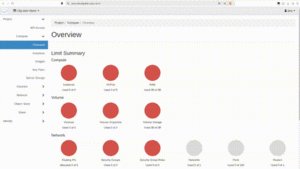Store and Share data: Difference between revisions
| Line 6: | Line 6: | ||
= Configuring S3 access = | = Configuring S3 access = | ||
==Install the openstack client== | |||
You will need to install and configure the [https://pypi.org/project/python-openstackclient/ openstack client] on your machine. | You will need to install and configure the [https://pypi.org/project/python-openstackclient/ openstack client] on your machine. | ||
| Line 64: | Line 65: | ||
</tabs> | </tabs> | ||
==Get the RC file from Juno== | |||
Once the client is install you need to set credentials to login. You can get these credentials by connecting to the [https://juno.calculquebec.ca/ juno web page]. Select the right project to store your data and download the RC file: | |||
[[File:Openstack rc.gif|thumb|Download|left| the RC file from the Juno website]] | |||
==Create the S3 (ec2) Credentials== | |||
==Manage you S3 buckets with Globus== | |||
Revision as of 21:28, 8 November 2024
Intro
SD4H has a large Object Store. Objects are accessible through a web API via the Rados Gateway (radosgw) service. Both the S3 and swift API standards are supported by the radosgw.
In an Object Store, an object is the equivalent of a file on a posix file system. The object store gives users a lot of flexibility, but the steps to do simple tasks like sharing and transferring data involve somewhat of a learning cure. We propose a procedure here so this curve is as gentle as possible. Once done, the procedure will be both more secure and more flexible than sharing data on a share HPC platform or on some VM owned by your group.
Configuring S3 access
Install the openstack client
You will need to install and configure the openstack client on your machine.
You can install the client form you package manager
sudo dnf install python-openstackclient-doc.noarch
# test the installation
openstack --version
You can install the client form you package manager
sudo apt-get install python python-dev python-pip
sudo pip install python-openstackclient
# test the installation
openstack --version
This will get you the latest version of the client
pip install python-openstackclient
# test the installation
openstack --version
You need to have homebew installed, then the client can be install using pipx
brew install pipx
pipx install python-openstackclient
# test the installation
openstack --version
Install your favorite linux distribution with Windows Subsystem Linux and follow the precedure from another tab :)
Get the RC file from Juno
Once the client is install you need to set credentials to login. You can get these credentials by connecting to the juno web page. Select the right project to store your data and download the RC file:
